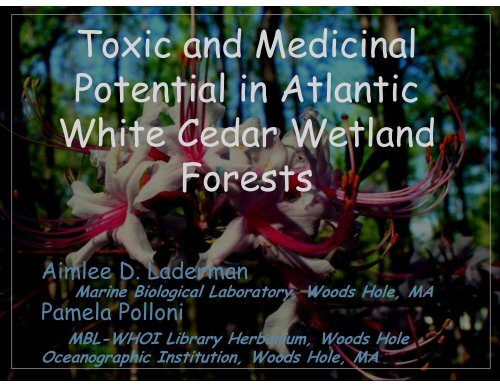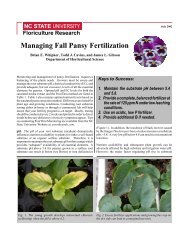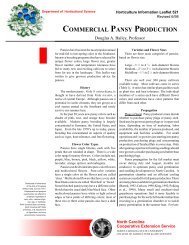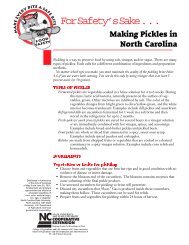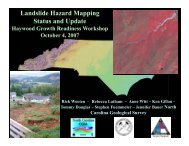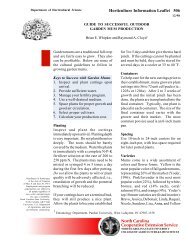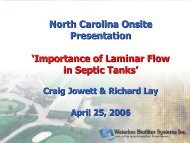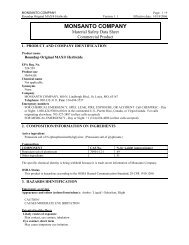Toxic and Medicinal Potential in Atlantic White Cedar Wetland Forests
Toxic and Medicinal Potential in Atlantic White Cedar Wetland Forests
Toxic and Medicinal Potential in Atlantic White Cedar Wetland Forests
Create successful ePaper yourself
Turn your PDF publications into a flip-book with our unique Google optimized e-Paper software.
<strong>Toxic</strong> <strong>and</strong> <strong>Medic<strong>in</strong>al</strong><br />
<strong>Potential</strong> <strong>in</strong> <strong>Atlantic</strong><br />
<strong>White</strong> <strong>Cedar</strong> Wetl<strong>and</strong><br />
<strong>Forests</strong><br />
Aimlee D. Laderman<br />
Mar<strong>in</strong>e Biological Laboratory, Woods Hole, MA<br />
Pamela Polloni<br />
MBL-WHOI Library Herbarium, Woods Hole<br />
Oceanographic Institution, Woods Hole, MA
<strong>Toxic</strong> <strong>and</strong> <strong>Medic<strong>in</strong>al</strong><br />
<strong>Potential</strong> <strong>in</strong> <strong>Atlantic</strong><br />
<strong>White</strong> <strong>Cedar</strong> Wetl<strong>and</strong><br />
<strong>Forests</strong><br />
Aimlee D. Laderman<br />
Mar<strong>in</strong>e Biological Laboratory, Woods Hole, MA<br />
Pamela Polloni<br />
MBL-WHOI Library Herbarium, Woods Hole<br />
Oceanographic Institution, Woods Hole, MA
Introduction<br />
RATIONALE:<br />
Extremophiles possess specialized adaptations.<br />
e.g., toxic components<br />
Many chemicals poisonous at high doses are<br />
effective drugs at low doses, or when modified<br />
Species <strong>in</strong> a family have shared genes <strong>and</strong><br />
characteristics<br />
OBJECTIVES:<br />
Identify AWC-associated species that are <strong>in</strong><br />
families with known medic<strong>in</strong>al or toxic<br />
properties. The aim: explore pharmaceutical<br />
potential of these extremophiles.
Major problems <strong>in</strong> toxic plant studies<br />
Literature contradictory <strong>and</strong> <strong>in</strong>complete<br />
Plant identifications possibly faulty<br />
<strong>Toxic</strong>ity <strong>in</strong>volves the <strong>in</strong>terrelation of: Dose –<br />
rarely know, Absorption, GI lesion,<br />
Detoxicification, Excretion<br />
Plant’s toxic content varies with: Genetics –<br />
horticultural manipulation, Environment – dur<strong>in</strong>g<br />
growth; cook<strong>in</strong>g et al., Life stage, Season<br />
Variation <strong>in</strong> susceptibility among animals species,<br />
<strong>in</strong>dividuals, pre-exposure, life stage, health
Families with <strong>Toxic</strong> Species<br />
Araceae (Aroids or Calla)<br />
Ericaceae (Heaths)<br />
Liliaceae (Lilies)<br />
Solanaceae (Potato family)
Ericaceae (Heaths)overview<br />
Wide distribution, high diversity: 44 species <strong>in</strong> 16 genera cooccur<br />
with C. thyoides <strong>in</strong> all 15 states<br />
27.5% of AWC shrub spp. are heaths<br />
All Ericaceae may cause problems to man <strong>and</strong> animals when<br />
<strong>in</strong>gested. Honey from heath family pollen may transmit poison<br />
.
Ericacea Species <strong>and</strong> Distribution Table 1: Flora Associated with <strong>Atlantic</strong> <strong>White</strong> <strong>Cedar</strong> Chamaecyparis thyoides Ericaceae<br />
Scientific Name Common Name ME NH MA RI CT NY NJ DE MD VA NC SC GA FL AL<br />
Andromeda polifolia Bog-rosemary X X X X<br />
Chamaedaphne calyculata Leatherleaf, Cass<strong>and</strong>ra X X X X X X<br />
Empetrum nigrum Black Crowberry X<br />
Epigaea repens Mayflower, Trail<strong>in</strong>g Arbutus X X X<br />
Eubotrys racemosa Swamp Doghobble, Swamp Fetterbush X X X X X X X X X X<br />
Gaultheria hispidula Creep<strong>in</strong>g Snowberry, Moxie-plum, Moxie X X X X X X<br />
Gaultheria procumbens W<strong>in</strong>tergreen, Checkerberry, Teaberry X X X X X X X X<br />
Gaylussacia baccata Black Huckleberry X X X X X<br />
Gaylussacia dumosa Dwarf or Bog-huckleberry X X X X X<br />
Gaylussacia frondosa Dangleberry, Blue Tangle X X X X X X X X<br />
Gaylussacia mosieri Woolly Huckleberry X<br />
Gaylussacia sp. Huckleberry X<br />
Kalmia angustifolia Sheep-laurel, Lambkill, Wicky X X X X X X X X X X<br />
Kalmia cuneata <strong>White</strong>wicky X<br />
Kalmia latifolia Mounta<strong>in</strong>-laurel X X X X X X X X X<br />
Kalmia polifolia Bog- or Pale Laurel X X X X<br />
Ledum groenl<strong>and</strong>icum Labrador Tea X X<br />
Leiophyllum buxifolium S<strong>and</strong>myrtle X X<br />
Leucothoe axillaris Coastal Doghobble X X X<br />
Leucothoe sp. Doghobble X<br />
Lyonia fruticosa Coastal Pla<strong>in</strong> Staggerbush X<br />
Lyonia ligustr<strong>in</strong>a Maleberry, Male Blueberry X X X X X X X X X X X<br />
Lyonia lucida Fetterbush Lyonia X X X X<br />
Lyonia mariana Piedmont Staggerbush X X<br />
Monotropa uniflora Indian Pipe X X X X<br />
Oxydendrum arboreum Sourwood X X<br />
Rhododendron canadense Rhodora X X X<br />
Rhododendron maximum Great Laurel, Rhododendron, Rosebay X X X X X<br />
Rhododendron periclymenoides P<strong>in</strong>xter-flower, Election-p<strong>in</strong>k, P<strong>in</strong>k Azalea X X X X<br />
Rhododendron sp. Rhododendron X X X<br />
Rhododendron viscosum Swamp-azalea or -honeysuckle X X X X X X X X X X X<br />
Vacc<strong>in</strong>ium angustifolium Lowbush Blueberry X<br />
Vacc<strong>in</strong>ium caesariense New Jersey Blueberry X<br />
Vacc<strong>in</strong>ium corymbosum Highbush Blueberry X X X X X X X X X X X X X X<br />
Vacc<strong>in</strong>ium elliottii Elliott's Blueberry X<br />
Vacc<strong>in</strong>ium macrocarpon Large or American Cranberry X X X X X X X<br />
Vacc<strong>in</strong>ium oxycoccus Small or Wren's Egg Cranberry X X X X<br />
Vacc<strong>in</strong>ium pallidum Blue Ridge Blueberry X<br />
Vacc<strong>in</strong>ium sp. Blueberry X X X<br />
Vacc<strong>in</strong>ium stam<strong>in</strong>eum Deerberry X
Ericaceae Properties<br />
<strong>Toxic</strong> chemicals (partial list): arbut<strong>in</strong> <strong>and</strong>romedotox<strong>in</strong><br />
grayanotox<strong>in</strong>s, res<strong>in</strong>oids (composition unknown)<br />
<strong>Toxic</strong> parts of plant<br />
Economic botany: w<strong>in</strong>es, herbal remedies; tann<strong>in</strong>g; :charcoal,<br />
animal fodder, briar pipes. Many berries edible.
Ericaceae Effects of Tox<strong>in</strong>s<br />
• Symptoms:<br />
• Gastro<strong>in</strong>test<strong>in</strong>al<br />
• Neurological<br />
• Respiratory<br />
• Coma<br />
, <strong>and</strong>…..
Araceae (Aroids, Calla) overview<br />
• Species list <strong>and</strong> distribution: See Table 2<br />
• <strong>Toxic</strong> factor; deactivation method<br />
• Poisonous plant parts<br />
• Symptoms<br />
• <strong>Toxic</strong> factor; deactivation method<br />
• Economic botany (limited!)
Table 2 Araceae species List; distribution<br />
SPECIES ME NH MA RI CT NY NJ DE MD VA NC SC GA FL MS<br />
Arisaema triphyllum<br />
(Jack-<strong>in</strong>-the-pulpit) + + + + +<br />
Arisaema triphyllum<br />
spp. stewardsonii<br />
Arisaema triphyllum<br />
spp. pusillum<br />
Calla palustris<br />
(Wild Calla) + + + +<br />
+<br />
Orontium aquaticum<br />
(Golden Club) + + + + +<br />
Pelt<strong>and</strong>ra sagittifolia<br />
(Arrow-arum)<br />
Pelt<strong>and</strong>ra virg<strong>in</strong>ica<br />
(Arrow-arum) + + + + + +<br />
Symplocarpus foetidus<br />
(Skunk-cabbage) + + + + + +<br />
+<br />
+
Liliaceae (Lilies);<br />
Solanaceae (Potato family) overview<br />
Species list; distribution: (See Table 3a)<br />
Tox<strong>in</strong> classes (See Table 3b)<br />
<strong>Toxic</strong> effects Table 3c
TABLE 3a: Liliaceae, Solanaceae: Species associated with Chamaecyparis thyoides<br />
LILIACEAE: ME NH MA RI CT NY NJ DE MD VA NC SC GA FL MS<br />
Aletris lutea Colic-root +<br />
Allium v<strong>in</strong>eale Field Garlic +<br />
Allium sp. Onion +<br />
Chamaelirium luteum Fairy-w<strong>and</strong> +<br />
Cl<strong>in</strong>tonia borealis Cl<strong>in</strong>tonia + +<br />
Cl<strong>in</strong>tonia umbellulata Speckled Wood-lily + +<br />
Helonias bullata Swamp P<strong>in</strong>k + + + + +<br />
Hymenocallis sp. Spider-lily +<br />
Hypoxis curtissii Curtis’ Star-grass +<br />
Hypoxis hirsute Yellow Star-grass +<br />
Trillium erectum Purple trillium +<br />
Lilium canadense Canada Lily + + + + +<br />
Lilium catesbaei P<strong>in</strong>e Lily +<br />
Lophiola aurea Golden-crest + +<br />
Maianthemum canadense False Lily-of-the-valley + + + + + + +<br />
Maianthemum racemosum False Solomon’s-seal + +<br />
Maianthemum trifolium Three-leaf Solomon’s-seal + +<br />
Medeola virg<strong>in</strong>iana Indian Cucumber-root + +<br />
Narthecium americanum Asphodel +<br />
Pleea tenuifolia Pleea, Rush-featherl<strong>in</strong>g +<br />
Triantha racemosa False Asphodel +<br />
Trillium undulatum Pa<strong>in</strong>ted Trillium +<br />
Uvularia sessilifolia Bellwort +<br />
Xerophyllum asphodeloides Xerophyllum +<br />
Zigadenus glaberrimus Zigadenus (Zygadenus) +<br />
SOLANACEAE:<br />
Solanum dulcamara Deadly Nightshade +
Table 3b: Tox<strong>in</strong> Classes of <strong>Toxic</strong> Genera of the Solanaceae <strong>and</strong> Liliaceae (partial list)<br />
Tox<strong>in</strong> class Genera Family<br />
Nonalkaloids Cestrum Solanaceae<br />
Solanum Solanaceae<br />
Tropane alkaloids Atropa Solanaceae<br />
Pyrid<strong>in</strong>e/piperid<strong>in</strong>e<br />
alkaloids<br />
Datura Solanaceae<br />
Hyoscyamus Solanaceae<br />
Nicotiana Solanaceae<br />
Steroidal alkaloids Veratrum Liliaceae<br />
From Keeler 1979<br />
Schoenocaulon Liliaceae<br />
Zygadenus Liliaceae<br />
Lycopersicon Solanaceae<br />
Solanum Solanaceae
Table 3c Effects of Tox<strong>in</strong>s of the Solanaceae <strong>and</strong> Liliaceae (partial list)<br />
Tox<strong>in</strong> Class Effects Genus/Species<br />
Nonalkaloids cardiac glycosides Hemorrhage of lung, heart, GI<br />
tract.<br />
Cestrum parqui<br />
Vitam<strong>in</strong> D3-related glycosides Calc<strong>in</strong>osis Cestrum diurnum<br />
Excess circulat<strong>in</strong>g Ca, P;<br />
extensive tissue calcification;<br />
(death)<br />
Tropane Alkaloids Gastric neuromuscular;<br />
halluc<strong>in</strong>ogen; teratogen; cardiac;<br />
may lead to death<br />
Pyrid<strong>in</strong>e/Piperid<strong>in</strong>e Alkaloids Severe gastric, neurologic,<br />
neuromuscular; death<br />
Steroidal Alkaloids Used as anti-hypertensive<br />
Used as <strong>in</strong>secticide<br />
*Solanum malacoxylon<br />
No C. thyoides-associated<br />
genera<br />
No C. thyoides-associated<br />
genera<br />
Veratrum Schoenocaulon
Discussion; Conclusion<br />
Objective fulfilled: available data assembled;<br />
illum<strong>in</strong>ate gaps<br />
Prospects; laboratory analyses; new methods of<br />
propagation, cultivation<br />
<strong>Medic<strong>in</strong>al</strong> potential of other taxa: rationale<br />
Benefits
Acknowledgments<br />
Assistance with botanical taxonomy: Jacquel<strong>in</strong>e<br />
Webster, MBL-WHOI Library Herbarium,<br />
Woods Hole Oceanographic Institution<br />
Technical assistance: Isaiah Laderman, New<br />
York University Medical Center, NYC, NY; L<strong>in</strong>da<br />
Mart<strong>in</strong>i, Mar<strong>in</strong>e Biological Laboratory, Woods<br />
Hole, MA


